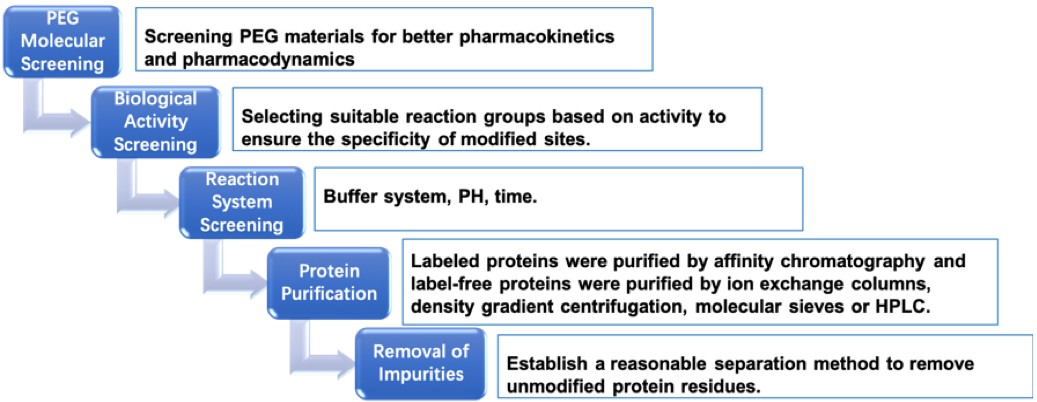Service Line:+86-022-82164980
Address:FL-4, Building A5, International Enterprise Community, Tianjin, China
Email:[email protected]
The introduction of polyethylene glycol (PEG) into biomolecule and biosimilar is well known to enhance the stability and pharmacological properties of proteins, peptides, biosimilar antibody conjugates and small molecule compounds. As a synthetic polymer with high hydrophilicity, PEG is widely used to prolong the circulation time of proteins, increase the aqueous solubility of therapeutic molecules and reduce the immunogenicity of biopharmaceuticals. In many cases, PEG (polyethylene glycol) modification can not only significantly improve the physicochemical properties of the biosimilar, but also alter the pharmacokinetics and pharmacodynamics of the biosimilar. With years of experience in protein modification services, KMD Bioscience provides custom PEGylated conjugates and PEGylation services for proteins, peptides, antibody, oligonucleotides, and small molecules.
Protein PEGylation Service Process

Fig 1: Protein PEGylation types

Fig 2: Protein PEGylation Process
Protein PEGylation Background
PEGylation is the process of attaching polymer polyethylene glycol chains to molecules (most typically peptides, proteins, and antibody fragments) to improve the effectiveness of molecular synthesis and the safety of drug synthesis.
The first step is to functionalize one or both ends of the PEG polymer appropriately to prepare chemically active or activated PEG polymer derivatives, in order to attach PEG to the desired molecule.
For proteins, typical reactive amino acids include lysine, cysteine, histidine, arginine, aspartic acid, glutamic acid, serine, threonine, and tyrosine. N-terminal amino and C-terminal carboxylic acids can also be used as site-specific sites by binding with aldehyde functional polymers.
The development process of PEGylation:
The technique for forming the first generation of PEG derivatives typically involves reacting PEG polymers with hydroxyl reactive groups (usually acid anhydrides, acyl chlorides, chloroformates, and carbonates).
In the second generation of PEGylation chemistry, more effective functional groups such as aldehydes, esters, amides, etc. can be used for binding.
The third generation of PEGylated agents, in which the polymer is branched, Y-shaped, or comb shaped, has the characteristics of reduced viscosity and less likely to accumulate in organs. Recently, an enzymatic PEGylation method has also been developed.
Protein PEGylation Service Highlights
--Rich experience in protein PEGylation and protein labeling technology
--Reasonable timeline and cost
--GMP-grade proteins
--KMD Bioscience can provide protein labeling services and provide protein tag such as GST, HIS, etc
--KMD Bioscience also provides a rage of upstream and downstream protein assay services such as protein function assay, protein interaction assay, and protein concentration assay
How to Order?

If you have any questions regarding our services or products, please feel free to contact us by E-mail: [email protected] or Tel: +86-400-621-6806